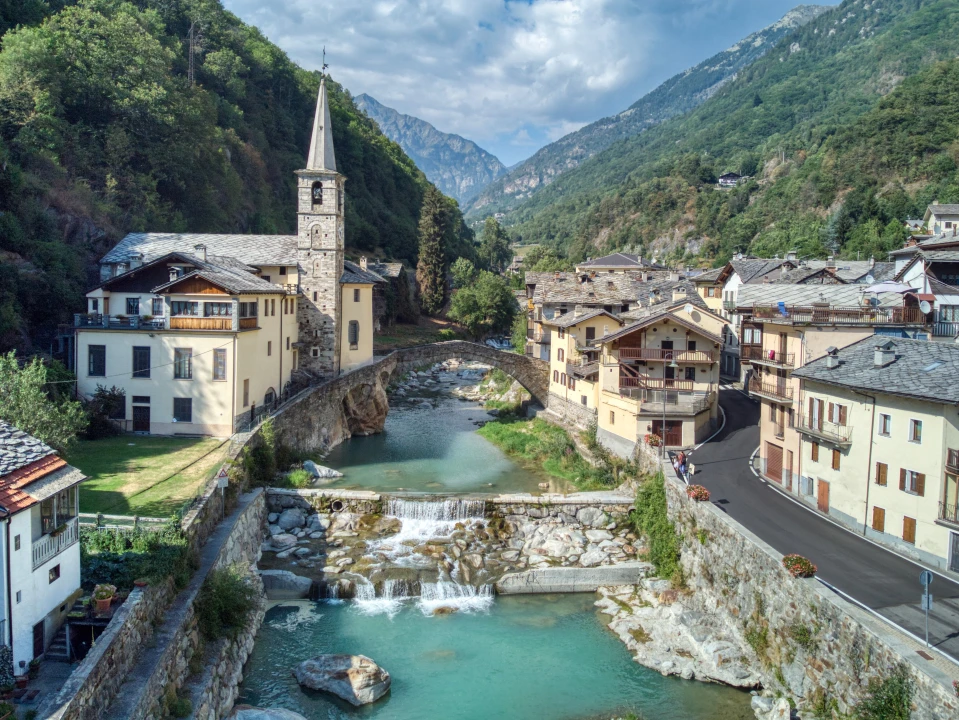The parish church of Sant’Antonio Abate (St. Anthony Abbot), built in 1494 by head master Antonio Goyet, has several interesting artistic, historical and architectural features, including the chancel with round apse dating from the 15th century, the ribbed vault with stone ribs covered with lime and a rose window in the center bearing the Vallaise coat of arms, five altars in Baroque and Rococo style, the 17th-century carved wooden main door, consisting of four panels with the figures of St. Grato, St. Jocund, St. Anthony and St. Bear and six panels with leaves and flowers.
The stone bridge that crosses the Lys stream and leads to the parish church consists of a single 22-meter arch. It is certain that the bridge dates back to at least the 17th century, as it appears in its present arrangement in one of the frescoes in the Vallaise palace of the costette of Arnad.
Scattered throughout the territory, there are as many as 11 chapels, many of them frescoed, built by the maçons (masons) of each village, which symbolize the autonomy of each hamlet.
The village of Farettaz, located about 1.5 km from the Chief Town, represents a typical “moyenne montagne” rural Aosta Valley permanent settlement, with the characteristic structures necessary for sustenance and community life, such as the bread-baking oven, school, chapel, washhouse and mill.
The Mont Mars Nature Reserve, established in 1993, covers 390 hectares on the left orographic slope of the lower Lys Valley and is the largest of the nature reserves in the Aosta Valley. It stretches between an altitude of 1670 m and 2600 m, presenting a variety of typical alpine environments, such as forests alternating with pastures, alpine meadows, lakes, scree and rock faces. Dominating the entire area is Mount Mars, which, at 2,600 m, represents the highest peak.
The Guillemore Gorge is an ancient mule track that leads to the “Gouffre de Guillemore,” a deep gorge carved into the rock by the Lys stream, where it plunges with a striking drop.
The Ecomuseo della Media Montagna (Middle Mountain Ecomuseum) allows visitors to immerse themselves in the rural reality of Fontainemore and understand the close human-environment relationship that has characterized its life. Part of the museum houses a collection of carpenter's tools and other traditional occupations. Of particular importance are the mason's tools, a trade characteristic of this village, for which the inhabitants were famous even abroad, where they were called upon to lend their labor in the summer.
The name
According to tradition, the monk St. Maurus came from Oropa to a small village in the Lys Valley, where he prayed in the small square causing a spring to gush forth. He urged the townspeople to build a chapel in honor of St. Anthony the Hermit, which happened in the 7th c. Since then the village was given a name that recalls the saint and the spring, “Fontaine Maur,” from which Fontainemore comes.
History
In the 12th century the Lords of Vallaise made their appearance in the Lys Valley, who exercised their dominion and jurisdiction over the Valley until the 18th century, for a period of about six hundred years. Many documents prove that Fontainemore was a mandiment of the Barons Vallaise for over 185 years (1592 to 1777). Hearings were held in Colombit, where sentences were also promulgated: the remains of the prisons and the ancient court can still be seen here.
In 1678 Jean Pierre Aguettaz, a mason from Fontainemore, donated 1,000 scudi so that a school could be founded. The small village thus had the first public elementary school established in the Aosta Valley. Between the 1700s and 1800s as many as 6 hamlets had a school building, and in the main town, in addition to the elementary school, there was a kindergarten and the high school of Geometry.
Throughout the centuries the phenomenon of emigration was a normal condition for the population of Fontainemore. Of particular importance was the emigration of masons, which took place from spring to late autumn. The “maçons” (masons) headed mainly for France and Switzerland, leaving all agricultural occupations to the women. Towards the end of the 19th and the beginning of the 20th century, emigration took on a definitive character and also changed the profession: from “maçons” the fontainemorains became “chauffeurs de cabs,” drivers of the famous Parisian public cars.
Linked to the emigration of the masons of Fontainemore, there is a particular tradition: in 1380 the relics of St. Grato were stolen from the cathedral in Aosta; some masons from Fontainemore, who worked in Savoy, found them and managed to bring them back to the Valley by crossing the hill over the lake of Valgrisenche (Lake of St. Grato). In memory of this fact, to this day, Fontainemore masons (dressed in traditional costume) are still reserved the honor of carrying St. Grato's relics during the procession to Aosta on the feast day (Sept. 7).
The village dish
“Bane e beuro,” chestnuts and butter from the Francoprovençal dialect (patois), is a typical autumn dish for the preparation of which chestnuts harvested in the area are cooked and served with small knob of butter.




